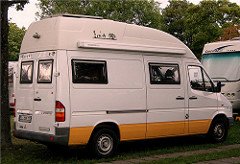- Category: Campervan
- Written by Paul Chubb
- Hits: 554
Choosing a Camper van
Why a van?
Ultimately this whole blog is about enabling travel. There are many different ways that you can travel: everything from timeshare to taking a walk. In our case we wanted to have some comfort while being able to choose where we went. The three options that maximise each side of the trade off between these two requirements are caravans, camper trailers and camper vans.

Hiace Commuter
Camper trailers are generally a cheap and light weight option. Their price range lies at the cheaper end of the spectrum. Generally they also have a better range of destinations than either caravans or camper vans. A rugged camper trailer, a four wheel drive and you can go anywhere.
Camper trailers are lighter so you don't need as big a car as a caravan either. However, of the three they are also usually the least comfortable with the only fixed furniture a double or queen size bed. All seating, outside of the car, is foldable and there is only canvas between you and the weather.
Caravans offer a solid roof over your head and are better at modifying the environment for your comfort. They also generally have better furniture and facilities. However they require a large car such as a four wheel drive to tow them and towing is not as easy as simply driving a car. They tend to travel well on tarmac but may be limited off road. They are also generally limited to powered sites.
Camper vans sit in the middle between the other two options. Two clear downsides are that you have to have a specialised vehicle - the van itself - and if you want to go somewhere when travelling you have to take everything with you. After picking your spot, to go grocery shopping, you pack up and go. This can lead to losing the prime camping real estate.
Budget
The first consideration is the amount of money that you are prepared to spend, You can find vehicles listed as camper vans as low as a couple of thousand dollars, however you won't get much for that. At this end of the market, there are many who are prepared to throw a matress in the back of a geriatric van and style it as the latest camping innovation. At the other end of the value range you can spend hundreds of thousands of dollars and get a veritable palace on wheels. Having a feeling for your budget range helps you to single out the possibilities.
In our case we had a split understanding of budget. We were prepared to spend between ten and twenty thousand dollars to get a solid van that had everything that we wanted. Alternatively we were prepared to spend up to five or six thousand dollars on a van that would allow us to understand whether this great adventure was for us - even for us at this time of life before retirement. The first amount would be a stretch, the second would be easily covered.
The Backpacker Malady
Australia is a backpacker destination. A preferred way of seeing this country for backpackers is the camper van. Lots of vans change hands between backpackers each year, mainly at the bottom end of the market. Generally backpackers have limited understanding of Australian laws and requirements and limited money. They are looking for the easy and cost effective solutions and you may be caught by their lack of understanding. As always and even more so: Caveat Emptor
Van Options

CC-BY-SA Norbert Schnitzler
Because our budget is now defined, we can now look at vans. The vans in our price range are generally built on commercial platform bases. They are the kind of vans that tradesmen use to carry their tools and goods. They are small, generally 2 berth. The main models are:
- Mercedes Sprinter
- Mazda E series (E1800, E2000 etc)
- Kia Pregio
- Toyota Hiace
The Sprinter is probably the biggest of the above. They are considered a solid van. Our expert source - a plumber - says that his tended to only have small things go wrong like knobs etc. However they have a reputation for being expensive in parts.
The Pregio is a van we looked hard at before passing. We saw some very clever layouts that we liked, however the Pregio has a very poor reputation. Our expert described it as the worst van he ever owned. It has a tendency to wear the front tyres since there are no wheel alignment adjustments. Another biggie for a camper van, in which you will do long distances, is the fact that the seats don't adjust.
While the Sprinter is the biggest, the Mazdas are towards the smallest. In their favour though they have a reputation for reliability and little if any rust.
In the end we chose a Toyota Hiace which is one of the most popular camper van bases. The Hiace has a very strong reputation and this fits with our experience of other Toyotas - we currently own four.
Choosing a Hiace

CC-BY Riley
Having chosen the Hiace as the base of our camper van, we still had many other decisions to make. Besides the many different year models, the Hiace comes in at least 3 different sizes (based on 1995 other years vary in their lengths):
- Short Wheel Base (SWB about 4.5m length)
- Long Wheel Base (LWB about 4.5m length)
- Super Long Wheel Base/Commuter (SLWB/Commuter about 5m length)
In addition the Commuter has the highest ceiling.
Since we are looking for a camper van we must also be aware that some of the factory converted Hiaces, received a fibre glass high top. This not only made head room easier, but it added storage or even an extra berth.
Having looked at the adverts of about 100 Hiaces, there seem to be three main layouts. The home made layouts consist of a double or queen bed in the back with usually cupboards just behind the driver and passenger seats. There are two factory layouts: one consists of two bench seats running length ways at the back with a table that converts to a double/queen bed. The kitchen and cupboards are behind the driver and passenger seats.
The other layout consists of bench seats and table running across the van behind the driver and passenger seats. These convert to a bed. This leaves the back of the van to host the kitchen and cupboards.
In most cases, Hiaces are limited to two berths. The main exceptions are the high tops that add a mezzanine that can take a single bed. Some listed as three berths were not in our opinion. Just remember the backpackers. They may be happy sleeping three adults to a double bed and may describe their van as having three berths when the only sleeping accommodation is the double bed.
Buy or Build
Generally a well kept factory layout will be of better quality than a home made layout. We decided that we didn't like either of the factory layouts. In addition those layouts were usually towards the middle of our stretch budget and the vans were old and dowdy. We required three seats and three berths which immediately ruled out most of the options. In the end we decided to build for ourselves. We would create our own layout that included three berths and would meet our other requirements. While the base van would be old and dowdy, we would end up with everything we wanted.
We purchased a Hiace Commuter that had a minimal home made conversion - they removed the bus seats and added a matress - for $4800 that met all the requirements on our wishlist except one - we wanted an automatic instead of manual.
There were many arguments on names. Gramps, The Boffin, Happy Granny etc. Eventually the arguments died down and she was named "Tin Lizzy".
Places to look
There are several dealers around Australia that specialise in camper vans. There are also a few web sites that advertise private and dealer sales.
The two web sites we used the most were http://www.caravancampingsales.com.au and gumtree.com.au.
Caravan and Camping sales is the sister site of carsales.com.au. There are lots of vans on this site however they tended to be more expensive than our budget. The site we found the most useful was gumtree which hosts a large number of van adverts in our price range. Depending on your budget, you may find other sites more useful.

























